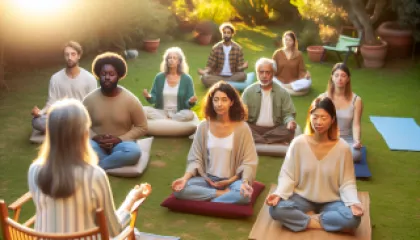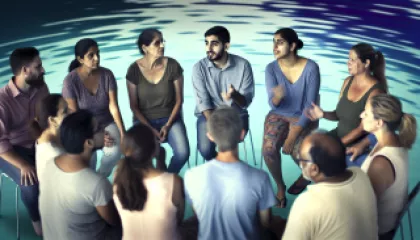10 Proven Work-Life Balance Techniques for a Fulfilling Life
10 Proven Work-Life Balance Techniques for a Fulfilling Life
As a young professional navigating the complexities of modern life, I've struggled with the elusive quest for work-life balance. The constant demands of my career, coupled with the desire to maintain a fulfilling personal life, often felt like a never-ending tug-of-war. But through trial and error, and a deep dive into the principles of work-life harmony, I've discovered a set of techniques that have transformed my outlook and allowed me to live a more balanced and enriched existence.
In this article, I'll share my personal journey and the 10 proven strategies that have helped me achieve a more harmonious way of living. Whether you're an ambitious go-getter, a busy parent, or someone simply seeking to find more joy and meaning in your day-to-day, these techniques can empower you to create a life that truly nourishes your mind, body, and spirit.
The Awakening: Recognizing the Need for Change
It all started a few years ago when I found myself in a state of constant stress and burnout. My days were a whirlwind of back-to-back meetings, endless email threads, and an ever-growing to-do list that left me feeling like I was drowning. At the same time, my personal relationships were suffering, and I struggled to make time for the hobbies and activities that once brought me so much fulfillment.
I knew something had to change, but the idea of overhauling my life felt overwhelming. It was then that I realized the true cost of neglecting my work-life balance. The long hours and constant pressure were taking a toll on my physical and mental health, and I could no longer ignore the warning signs.
The Journey Begins: Prioritizing Self-Care and Boundaries
The first step in my journey toward work-life balance was to make self-care a non-negotiable priority. I started by carving out time each day for activities that nourished my mind, body, and soul. This included things like meditation, exercise, and simply taking breaks to step away from my desk and clear my head.
I also had to learn the art of setting boundaries – both with my employer and with myself. I began saying "no" to tasks and commitments that didn't align with my priorities, and I made it a point to leave the office at a reasonable hour, even if it meant leaving some work for the next day.
These small but impactful changes were the foundation for a more balanced life, and they helped me to regain a sense of control and agency over my time and energy.
Mastering Time Management: Strategies for Increased Productivity
As I continued to explore the principles of work-life balance, I realized that effective time management was key. I started experimenting with a variety of techniques, from the Pomodoro method to time blocking, and found that the most successful approach was a combination of strategies tailored to my unique needs and preferences.
One of the most impactful techniques I've adopted is the habit of prioritizing my tasks and focusing on the most important and high-impact activities first. This has helped me to eliminate the sense of constant overwhelm and ensure that I'm making meaningful progress on my goals, both personal and professional.
I've also discovered the power of delegation and outsourcing. By identifying tasks that can be delegated to others or automated, I've been able to free up valuable time and mental energy to dedicate to the things that truly matter.
The Art of Mindfulness: Cultivating Presence and Awareness
As I delved deeper into the realm of work-life balance, I realized that mindfulness was a crucial component. By learning to be present and fully engaged in the moment, I was able to find more joy and fulfillment in my daily activities, whether it was a productive work session or a leisurely weekend hike.
One of the most transformative practices I've adopted is the habit of mindful breaks. Throughout the day, I take short pauses to step away from my desk, take a few deep breaths, and reconnect with my senses. This simple act has helped me to combat the feelings of burnout and overwhelm, and it has allowed me to approach my work and personal life with a renewed sense of clarity and focus.
I've also found that incorporating mindfulness into my leisure activities has been incredibly beneficial. Whether it's savoring a delicious meal, engaging in a creative hobby, or simply enjoying the beauty of nature, the act of being fully present and immersed in the moment has enriched my life in profound ways.
Nurturing Relationships: Balancing Work and Personal Connections
One of the key aspects of work-life balance is the ability to nurture our personal relationships. As someone who previously prioritized work above all else, I've had to learn the importance of making time for the people who matter most in my life.
This has meant being intentional about scheduling regular quality time with my loved ones, whether it's a weekly date night with my partner, a monthly catch-up with close friends, or a family outing on the weekends. I've also made a conscious effort to be present and engaged during these interactions, putting down my phone and fully immersing myself in the moment.
Additionally, I've found that maintaining strong professional relationships can also contribute to a sense of work-life balance. By cultivating a supportive network of colleagues and mentors, I've been able to leverage their expertise, seek guidance, and even find opportunities for collaboration that enrich both my personal and professional lives.
The Power of Unplugging: Embracing Disconnection and Rejuvenation
In our constantly connected world, the ability to unplug and disconnect from work has become increasingly crucial for maintaining a healthy work-life balance. I've learned that setting firm boundaries around my digital devices and creating technology-free zones in my life has been transformative.
This has meant establishing rules around the use of my smartphone, such as no checking emails or social media during mealtimes or after a certain time in the evening. I've also discovered the joy of taking regular digital detoxes, where I intentionally step away from all screens and immerse myself in more analog activities like reading, journaling, or simply spending time in nature.
By prioritizing these periods of disconnection, I've been able to recharge, refocus, and approach my work and personal life with renewed energy and enthusiasm. It's a powerful reminder that sometimes the most important thing we can do for our well-being is to simply unplug and be present.
Embracing Flexibility and Adaptability
One of the key lessons I've learned on my work-life balance journey is the importance of embracing flexibility and adaptability. As much as we might strive for a perfectly balanced life, the reality is that our needs and priorities are constantly evolving, and the ability to roll with the punches is essential.
This has meant being open to experimenting with different routines and strategies, and being willing to adjust my approach as needed. It's also meant cultivating a mindset of resilience and embracing the inevitable ups and downs that come with navigating the complexities of modern life.
By fostering a sense of adaptability, I've been able to navigate challenging situations with more grace and find creative solutions that allow me to maintain a sense of balance and equilibrium, even in the face of unexpected curveballs.
Aligning Values and Goals: Cultivating a Purposeful Life
At the heart of my journey toward work-life balance has been a deep exploration of my core values and personal goals. By taking the time to reflect on what truly matters to me, I've been able to make more intentional choices about how I allocate my time and energy.
This has meant regularly revisiting my priorities and ensuring that my daily actions are aligned with my long-term vision for a fulfilling life. It's also meant letting go of activities and commitments that don't serve my higher purpose, even if they might offer short-term rewards or recognition.
By keeping my values and goals at the forefront of my decision-making, I've been able to create a life that feels meaningful and purposeful, one that nourishes my soul and allows me to contribute in ways that truly matter to me.
Cultivating Community and Support
As I've navigated the journey of work-life balance, I've come to appreciate the immense value of building a supportive community around me. Whether it's a network of like-minded professionals, a close-knit group of friends, or a nurturing family, having a strong support system has been a game-changer in my pursuit of a more balanced life.
This community has provided me with a safe space to share my struggles, seek advice, and find inspiration. It's also allowed me to cultivate meaningful connections and engage in activities that nourish my social and emotional well-being, which in turn has had a positive impact on my overall sense of fulfillment and contentment.
By prioritizing the cultivation of these supportive relationships, I've been able to create a powerful buffer against the stresses and demands of daily life, and I've found that the act of giving and receiving support has enriched my life in ways I never could have imagined.
Celebrating Small Wins and Embracing the Journey
As I reflect on my work-life balance journey, one of the most important lessons I've learned is the value of celebrating small wins and embracing the process, rather than solely focusing on the end goal.
It's easy to get caught up in the constant pursuit of perfection, always striving for the elusive "ideal" balance. But the reality is that work-life balance is a constantly evolving, nuanced, and highly personal journey. By acknowledging and celebrating the progress I've made, no matter how small, I've been able to maintain a sense of momentum and positivity, even during the more challenging moments.
I've also learned to embrace the journey itself, with all its twists and turns, as an opportunity for growth, self-discovery, and learning. Each obstacle, setback, and breakthrough has helped me to refine my strategies, deepen my understanding, and ultimately become more resilient and adaptable in the face of life's demands.
Conclusion: Embracing a Fulfilling and Balanced Life
The journey toward work-life balance is not a one-size-fits-all solution, but rather a deeply personal and evolving process. Through my own experiences, I've discovered a set of techniques that have transformed my life in profound ways, allowing me to cultivate a sense of harmony, fulfillment, and joy.
By prioritizing self-care, mastering time management, cultivating mindfulness, nurturing relationships, embracing unplugging, fostering adaptability, aligning with purpose, building a supportive community, and celebrating small wins, I've been able to create a life that truly nourishes my mind, body, and spirit.
I hope that by sharing my story and the lessons I've learned, I can inspire and empower others to embark on their own work-life balance journey, and to discover the transformative power of living a life that is truly in balance.
Key Takeaways:
- Recognize the need for change and make self-care a priority
- Develop effective time management strategies to boost productivity
- Cultivate mindfulness to find joy and presence in daily activities
- Nurture personal and professional relationships to create a supportive network
- Embrace the power of unplugging and disconnecting from work
- Foster flexibility and adaptability to navigate life's constantly changing demands
- Align your values and goals to create a purposeful and fulfilling life
- Build a supportive community to provide encouragement and guidance
- Celebrate small wins and embrace the journey, not just the destination
- Discover the transformative power of living a balanced and harmonious life
Key Words and Phrases:
Work-life balance, work-life harmony, self-care, time management, mindfulness, relationships, unplugging, adaptability, purpose, community, small wins, fulfilling life, balanced life, personal growth, professional development, productivity, stress management, well-being, life balance strategies, work-life integration, work-life flexibility, work-life boundaries, work-life transition, work-life harmony techniques, work-life balance coaching, work-life balance resources, work-life balance solutions, work-life balance support, work-life balance tools, work-life balance exercises, work-life balance activities, work-life balance counseling, work-life balance guidance, work-life balance expert, work-life balance coach, work-life balance therapist, work-life balance session.






